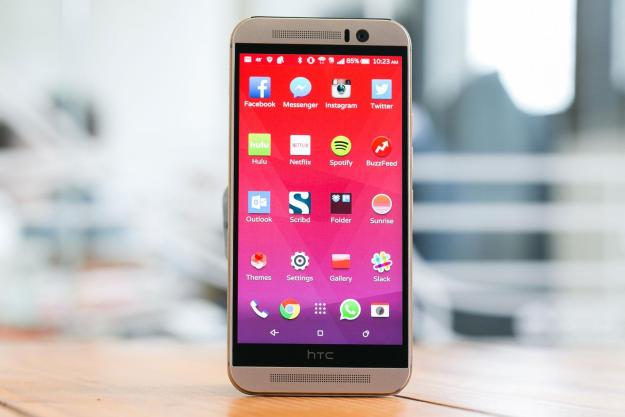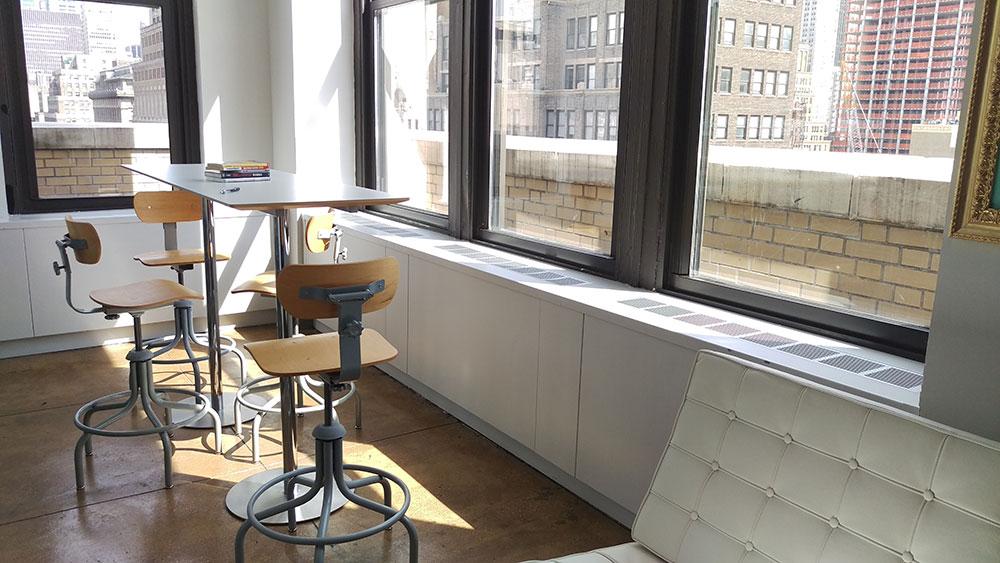
- A top-tier Android phone
- Two-toned metal design is stylish
- Android 5.0 Lollipop looks great
- Themes are a fun way to customize the UI
- Poor battery life
- Power/volume buttons awkward to press
- Annoying bezel and ledge on the edges
- Just an average camera
It ain’t easy living in Samsung’s shadow, and HTC keeps turning paler in the shade. Once the top dog in the Android aisle of the smartphone industry, HTC slowly, but surely lost its hold, and dropped the crown right into Samsung’s waiting hands. However, last year, Samsung took a hit, too. The difference is that Samsung came roaring back to life this year with the most beautiful phone it’s ever made. The spec sheet isn’t too different, but most flagship phones are minimal upgrades these days, anyway. Meanwhile, HTC launched the One M9, which looks a lot like last year’s model, and has a few key spec upgrades and software features.
The two devices are competing directly against each other – They were revealed at the same time, go on sale the same day, and are set at about the same price point. HTC isn’t backing down from this fight, which is really, a fight for its life.
Is the One M9 enough to challenge Samsung and put the One M9 at the head of the pack?
Classic HTC design in two metallic tones
HTC knows how to make pretty phones – It’s something the company has always held over the heads of its less design savvy competitors (ahem, Samsung). For years, HTC was the only Android smartphone maker to produce an all-metal flagship phone year in and year out. Now, the crowd is catching on: Samsung’s Galaxy S6 has a metal edge and a sleek glass back, LG’s reportedly also considering a metal phone, and a slew of Chinese phone makers have attractive metal phones on the market. Using metal isn’t enough to impress anymore, and HTC knows it.
The HTC One M9 is still one of the most attractive Android phones I’ve ever used.
By and large, the One M9 follows the design language of its predecessor, the M8. There are a few big differences, though, that completely change the feel of the phone. HTC put a strange little ledge on the edge of the device, which is supposed to make it easier to grip. The One M8 was totally smooth, and had a gorgeous aluminum unibody. It felt like a perfect, seamless beauty in my hands. In contrast, The One M9 feels choppy, and a little less premium.
The ledge wasn’t too disruptive once I got used to it. It also looks incredibly attractive on the silver and gold color option that I reviewed. HTC used a dual anodizing process to turn the aluminum two different metallic shades: gold on the edges and silver on the back. The ledge is also silver toned, as are the speaker grills at the top and bottom of the phone. Thanks to the ledge, the gold highlights really pop. The two tones look stylish and add a lot of flair, without making the device look gaudy.
HTC’s also moved the power button down to the right-hand side. It’s right below the two volume buttons, and while we’re glad it moved the power button away from the top of the device (where it’s hard to reach), there are a few problems with the buttons themselves. The power button is almost indistinguishable from the volume buttons, even though it has a light texture to it. Often, I found myself hitting the volume down button instead of the power button, or missing all three buttons.
That’s because the buttons are almost perfectly flush against the device. They literally disappear – so much so that it’s hard to press them. If you’ve got this phone in your pocket, you’re bound to press the wrong button. There’s no satisfying give to them, either, so I was never really sure whether I had pressed the buttons or not.
There’s also the matter of HTC’s weird little bezel around the screen. Not only is it a waste of space, it’s unattractive. When I look at the One M9’s lovely, high-res screen, all I see are those thin, black lines marring my view. They’re present on every HTC phone, and I just don’t get why they’re still there in an age when nearly bezel-free phones are everywhere.
Regardless of all these quibbles, the HTC One M9 is still one of the most attractive Android phones I’ve ever used. It’s really only second to the iPhone and maybe, the Samsung Galaxy S6.
Flagship specs and an overheating problem
The One M9 has a small-ish 5-inch 1,920 x 1,080 pixel LCD screen, which looks bright and offers true colors. It’s the same resolution as last year’s One, and that’s not a bad thing, what with the huge battery drain you get from a 2K screen. Those thin, black bezels and the thicker one at the bottom of the phone can get distracting when you’re watching video, though, and that’s unfortunate – especially since HTC has great BoomSound speakers on the front of the device.
HTC needs to pack a decent battery into its flagship phone.
The speakers give great sound – better than most smartphones – mainly because of their ideal position. You don’t cover them up with your palms when you hold it horizontally to view videos. In that regard, it’s a great phone for video streaming and sharing clips with your friends.
HTC’s One M9 is just as powerful as every other flagship smartphone out there with the 64-bit quad-core Snapdragon 810 processor and 3GB of RAM. It also has 32GB of storage that’s expandable with a MicroSD card – something that’s becoming more rare these days.
The One M9 didn’t disappoint in terms of speed or power, but it certainly did get piping hot while downloading apps, streaming video, and other taxing tasks. The metal back wasn’t burning, but it was uncomfortably warm at times, lending support for rumors that the Snapdragon 810 processor overheats. Even so, the phone didn’t crash as a result, and everything worked like normal. There wasn’t much of a noticeable difference in speed or power between the M9 and M8, but the new chip seems to give a slight boost.
Benchmark tests show the difference, and the One M9 scored well on all the tests. It pulled off a score of 24,300 on the 3D Mark Ice Storm Unlimited test, which is a tad higher than the 20,600 the M8 scored. There was a bigger difference in the Quadrant benchmark scores, with the M9 reaching 34,700 points and the One M8 only got 22,700 points.
In comparison to other new flagship phones, the One M9 got similar scores. The LG G Flex 2 managed 27,900 on Quadrant and 23,280 on the 3DMark test, both of which are lower than the M9’s scores. The One M9 also bested the iPhone 6 Plus on the 3DMark Ice Storm Unlimited test – It only managed 18,000 points.
Design your own theme from scratch
Smartphones are super personal, and each individual owner puts his or her own spin on the device with cases, stickers, backgrounds, custom launchers, and even ROMs. Some people put more effort into making each phone their own than others, but HTC thinks everyone secretly wants to have control over every aspect of their phone’s appearance, down to the icons. That’s why the HTC One M9 has this fun new app called Themes, which lets you customize many aspects of your device’s UI, from color pallets and textures, to fonts and icons.
Of course, we’re not all designers, so there are also a bunch of cool, preloaded themes from graphic designers. Theme enthusiasts can even make their themes public for others to download, and based on the sheer number of them in the Theme catalogue, this idea is quite popular. HTC is offering you the chance to design your own UI, and it’s a ton of fun.
I made a couple different ones from photos I’ve taken, and the app pulls key colors from the photo to suggest a color palette for the tops of apps. It’s truly amazing how much the font, colors, and icons you choose completely change the look of your whole phone. I’m also the kind of person who changes my phone’s background frequently, so the option to change things up dramatically whenever I want is appealing. Obviously, not everyone will agree, but if you’re artsy, you’ll enjoy HTC’s Themes.
To make things even better, Google’s Lollipop 5.0 is running on the HTC One M9, and boy does it look lovely. HTC’s Sense UI makes a few changes to the app drawer, but keeps most everything else the same, and that’s a good thing. My other favorite addition to HTC’s UI is the location-sensing widget that suggests apps to you, depending on where you are located.
HTC is offering you the chance to design your own UI, and it’s a ton of fun.
The M9 knows when you’re at work, and it’ll give you Google Drive, your calendar, and other helpful work-related apps right from the get-go. When you’re on the go, HTC offers up Google Maps, music, and other apps you might need out on the town. If you’re at home, it suggests YouTube, music, and other entertainment apps. Apparently, the widget will learn which apps you use in different locations, and populate the space accordingly. So far, it hasn’t learned my habits, but I’ve only been using it for a few days at this point.
In that same widget, HTC’s packed two folders: Downloads and Suggestions. The Downloads folder holds your most recent app downloads, so that they’re not scattered across your home screen randomly. The Suggestions folder lists some apps you might like based on your recent downloads. Some of the suggestions are okay, but you’d probably have to download a ton of apps for it to be super accurate.
Overall, HTC’s UI tweaks, the look of Sense, and the cool, new software features were my favorite part of the One M9. HTC excels at software, and it would be interesting to see what would happen if it got into the business of making more apps. It’s already on that path with Zoe, which should hit iOS soon, and is currently in the Google Play Store.
A much needed camera fix saves the day
HTC has tried a lot of different things with its camera hardware, and it’s finally gotten the memo that people didn’t really dig the UltraPixel camera. Now, the 4-megapixel Ultrapixel camera is on the front of the phone, so your selfies look great, and a new 20-megapixel shooter is right on the back.
An earlier version of HTC’s photo software had a few major issues, but those have been fixed now, and HTC’s One M9 performs well, taking decent shots in full sunlight and on overcast days. Occasionally, the camera had a hard time balancing dark and light in photos. Focusing in on the dark section of the photo would blow out the background completely, while focusing in on the middle tones of the image resulted in too much shadow. Of course, mixed light is something that most smartphone cameras struggle with, so it’s no surprise. Overall, the camera performed well, but it didn’t produce astounding, game-changing results.
Once again, HTC shines when it comes to software. Its photo editor is excellent, and all the new photo effects are ridiculously fun to play around with. I particularly enjoyed the prism effect, which breaks up the image with cool shapes, and the double exposure tool. The effects are easy to use, and you can make some really lovely photos with these tools. If HTC made the photo editor into an app, I’d download it immediately and use it to perfect pictures for Instagram.
Unacceptable battery drain
The HTC One M9’s 2,840mAh battery is as dismal as the iPhone 5’s. After a 30-minute subway commute, during which the screen is off the entire time and I’m only listening to an audiobook on Scribd, I got to the office, and the M9’s battery had already dropped from 100 percent to 80 percent. Around 4:30 p.m., after checking emails, sending texts, and performing other typical work activities on the device, the battery was down to 36 percent. I’ve gotten used to seeing my battery hover around 70 to 60 percent on the average workday with the iPhone 6 Plus, and that’s not even great battery life.
The DT Accessory Pack
Up your game and the get the most out of your gear with the following extras, hand-picked by our editors:
Anker 2nd Gen Astro E4 13000mAh battery pack ($300)
You’re going to want a portable power pack for your brand-new HTC One M9, and Anker’s Asto pack is one of the best. It has a huge battery that will recharge your phone at least three times before it conks out.
Speck CandyShell Grip case ($35)
If you find the gorgeous One M9 too slippery to grip, you’ll love Speck’s CandyShell Grip case. It’s slim, light, and protective, but it also comes in fun colors. Once you put this case on, you’ll never drop your phone again.
CaseMate Barely There Case ($18.50)
The One M9 is so pretty that you probably won’t want to cover it up at all. Still, you might want a bit of scratch protection, in which case, the CaseMate Barely There clear case is perfect for your needs. It’s cheap, prevents scratches, and lets you see the true beauty of your One M9.
Streaming one 40-minute episode of The Vikings on the M9 ate up 20 percent of its battery. It’s unacceptable and annoying. We streamed the same video on the Galaxy S6, and that phone only took a 9 percent hit in battery (which also isn’t great), after the 40 minutes were up. We’re not sure what’s making the One M9 waste battery so quickly, but it could be an issue with the processor.
Regardless, if HTC wants to compete with Samsung and LG, it needs to pack a decent battery into its flagship phone. This battery isn’t cutting it, and I’m not a power user. If I were at a trade show or streaming videos on this device, the M9 would be dead in the water much earlier in the day.
HTC Uh Oh protection will replace your phone
One of the best things you’ll get along with the One M9 if you choose to buy it, is HTC’s new Uh Oh protection plan. Uh Oh guarantees that if you break your phone or damage it in any way during the first year of ownership, HTC will replace your device, no questions asked.
As long as you can send the broken phone back and provide an IMEI number, HTC will ship a replacement unit and prepaid envelope in which to send the original, broken handset back within 30 days.
The best part of the plan? It’s free. Most manufacturers make you pay an arm and a leg to repair even the tiniest problem on your device, so this is a pretty huge deal, especially if you’re a butterfingers.
Conclusion
When it comes down to it, there are a lot of incredible smartphones on the market right now. It’s really hard to know which one to buy. Nearly all the Android flagship phones are powered by the same processor, have similar camera sensors, and screen resolutions of 1080p, or higher. The main differences come down to the physical appearance of the phone and software. Nowadays, you practically can judge a phone by its cover.
Now that Samsung’s Galaxy S6 got a much needed style upgrade, the HTC One M9 doesn’t have the high ground in terms of design. In fact, the S6 looks nicer to our eyes. Even LG’s G Flex 2 has an intriguing style, what with the curved body and fun color options. Sure, it’s plastic, but the upcoming LG G4 may not be, if the rumors of a metal back are true.
The Galaxy S6 ranks above the HTC One M9 in our regard, and although it’s a closer tie between the G Flex 2 and the M9, the G Flex 2 has a much nicer screen.
HTC’s One M9 shines in terms of software, and the hardware is nice. Still, if you’ve got a One M8, there’s really no reason to upgrade. However, if you’re on the M7 and are loyal to HTC, you’ll want to take a look at the One M9. Even so, take a peek at the Galaxy S6 while you’re in the shop, and you might change your mind. It’s not that the One M9’s a bad phone – it’s a great one –there are just a few options that are slightly better.
Highs
- A top-tier Android phone
- Two-toned metal design is stylish
- Android 5.0 Lollipop looks great
- Themes are a fun way to customize the UI
Lows
- Poor battery life
- Power/volume buttons awkward to press
- Annoying bezel and ledge on the edges
- Just an average camera




















